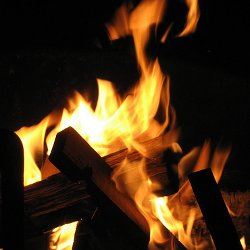Campfire is used to cook food, heat water, destroy rubbish and give warmth. You need to know how to fix a place for building the fire, learn the kinds of materials used in fire building, learn how to build a foundation fire, keep it going and as soon as you are through with it, PUT IT OUT.
Where to Build
On sand, rocks or dirt. (NEVER at the base of a tree or near enough for heat to kill the roots). Ground should be cleared of leaves, grass, sticks, etc. In a fireplace, temporary or permanent. Temporary fireplaces are mode of ditches or holes dug in dirt, green logs, rocks, bricks, clay or tin cans.
Materials to Use

- Tinder – Shavings or fuzz sticks, fine twigs, bundles of tops of bushes, pieces of fat pine, thin pieces of bark etc.
- Kindling – good dry sticks and twigs that should snap when broken. Sticks that bend and do not snap are green; use only after a hot fire is started.
- Fuel – Good firm pieces of wood. Wood that crumbles is rotten. It has lost all its life and will just smoulder and smoke without giving off any heat. Split wood burns well as the inside of a log is drier than the outside.
- Soft wood (pines, spruces, cedars, gray birch, apsen) is good for starting fires or for quick hot fires. It burns up quickly and needs constant refueling; it does not leave good coals.
- Hardwood (oak, hickory, yellow birch, maple, ash, mesquite, eucalyptus) burns slowly and yields coals that will last.
How to Make a Fire
Have fireplace area ready before you begin. Have ready at hand a handful of tinder, some kindling and wood. Take a few sticks of kindling and place in the fireplace at an angle to each other. Pile a good bit of tinder onto the kindling so there is air. Leave a small tunnel in which to insert the match from underneath. Strike match and insert into the small tunnel underneath the tinder and kindling.
As flame catches and begins to spread, add bits of tinder, placing gently on the flame until the fire is started. Add kindling, one by one, placing lightly where the flame is best, starting with small pieces, and gradually adding bigger pieces, forming a tepee shape. Remember to build the campfire gradually. When fire is going well, begin to add fuel in graduated sizes, building into the kind of fire you will need.
Putting Out the Fire
Let fire die down as much as possible. Scatter coals, break up big pieces, knock logs apart. Stir coals and sprinkle with water. Stir again. Repeat til there are no live coals. If you have no water, put on sand or dirt, and stir thoroughly. Cover with rocks or dirt and check before you leave.